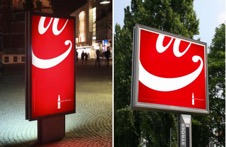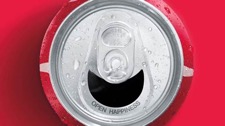The Truth Behind Why Smiles Sell And What This Means For Your Ads
Relevant topics Archive, Advertising
Advertisers know a smile can go a long way
When advertising a product to your potential customers, it’s very likely that the product won't just be there on its own. But instead, consumers will be able to put a face to it. More often than not, this face will have a smile on it.
With the exception of the fashion industry, smiling faces have never been scarce in the marketing context. From the merry supermarket manager – lighting up about a new collectible – to George Clooney, grinning over his coffee in a poster. There seems to be an unspoken consensus among marketers that a smile is a highly persuasive expression to use in visual marketing.
And of course, it seems like the most commonsensical thing doesn't it; wouldn't you want the people associated with your product to at least look like they're enjoying themselves?
So what's the science behind it? Do people respond to smiles subconsciously in the hopes of becoming as happy as the model in the picture? Smiles in ads have thus far been used merely intuitively, but the effects of smiles in printed ads have only recently been backed up by science.
Why does a smile sell?
Berg, Soderland and Lindstrom have recently labeled this the smile appeal, referring to a smile as the dominant facial expression on a human model in visual marketing.
What they found was that, yes indeed, a smile does work. They demonstrate that smiling faces in ads elicit more costumer joy as well as a greater product liking.
Not at all surprising. However, the interesting bit lies in why it works.

They found out that the smile appeal reaches its goal through emotional contagion. It works, simply because we feel better when we see other people smile. Why? Because that's just the way we're wired. In healthy human beings, mirror neurons do their job whenever we're exposed to any recognizable facial expression, making us experience emotions identical to ones being displayed. So when you look at a smiling face, however subtle, something in you automatically brightens up as well.
Newneuromarketing is looking for new authors! Are you up for the job?
Send us an e-mail at tim@newneuromarketing.com to become an author and start spreading knowledge.
Positive affect and buying
There is of course a plethora of ways to put customers in a good mood (e.g, music, scent marketing). Emotional contagion just happens to be one of them.
What we already know from previous research, is that when people feel good, it also effects their information processing and decision making as consumers. In this case, it resulted in a more positive attitude towards the product. In other words, the positive affect evoked by a smile spills over to the advertised brand.
Marketers have been notorious for creating the illusion of a world in which a product can make a person happy. This new insight sheds a different light on what a smile actually does to the viewer. In fact, it is the smile that puts a smile on your face rather than the product.
How to use the smile appeal – without being cheesy!
A genuine smile makes your brand more appealing. But how do you use the smile appeal without appearing cheesy?
First of all, it helps to hire actors who are capable of performing a truly authentic Duchenne smile. That is, a smile that also contracts the muscles surrounding the eyes. Secondly, a smiling exchange between two characters appears much more authentic than one directly aimed at the viewer. And if you want to get a little more creative, you can also place suggestions of smiles - symbols or shapes that our brains process as smiles - without using models at all.



Maybe it is the smile appeal that's been largely responsible for the success of Coca Cola's happiness campaigns? You're probably familiar with ear-to-ear smiles and chuckles, as well as many symbols that resemble the the human smile in this brand's ads. Perhaps, by repeatedly tapping into the smile appeal, the brand was able to equate carbonated sugar caffeine to happiness.
Be careful when displaying negative emotions
Of course, the real world isn't all about smiles. As a marketing or communication professional, you may have to deal with any emotion in the full spectrum of human emotions. But the results of this study, should make us careful when displaying negative emotions. We have to keep in mind that mirror neurons are always at work.
Let's look at sadness for example. If smiles make customers happy, do sad faces make customers sad? While sadness might in some cases seem relevant (e.g, for a charity campaign), it is not typically an emotion that activates people. In fact, neuromarketing research shows that micro lending requests had more success when people were exposed to happy faces.
Maybe you feel uncomfortable displaying cheery faces in a campaign regarding a cause in which joy is still a bit of a reach. You want to stay as close to reality as possible, and yet you don't want to paralyze your target group with sadness. This can be resolved by adding the smile appeal strategically, right at the 'call to action' moments. This can be done for example near the donate button on your website, or at the end of an advertisement. You want your target group to understand the real pain of the situation, but still feel good about making a donation.
So what about the fashion industry?
The facial expressions of fashion models usually tend to be a lot less cheerful; ranging anywhere from a disinterested to an intense, contemplative or arrogant look. I'd like to pose that all non-smiling looks are harmful per se. A model may as well be expressing an emotion representing traits or even a lifestyle that the target group aspires to have, indirectly leading to customer joy all the same.
While a smile is the most straightforward way to elicit happiness, we can't rule out that non-smiling expressions have the potential to cause consumer joy as well.
Will the smile appeal always work?
When the consumer has to make a well-informed decision regarding a high involvement product, a smile alone won’t cut it. Therefore, I expect the smile appeal to be more effective when it comes to low involvement products. However, in any case, it may contribute to an overall more positive attitude towards the brand or company.
Take home points:
- A smiling face is a powerful and incredibly simple tool to enhance customer joy and increase brand appeal
- Every emotion we see is contagious, through the magic of mirror neurons
- Negative emotions are contagious too; advertisers should be extremely careful when displaying them in their ads

